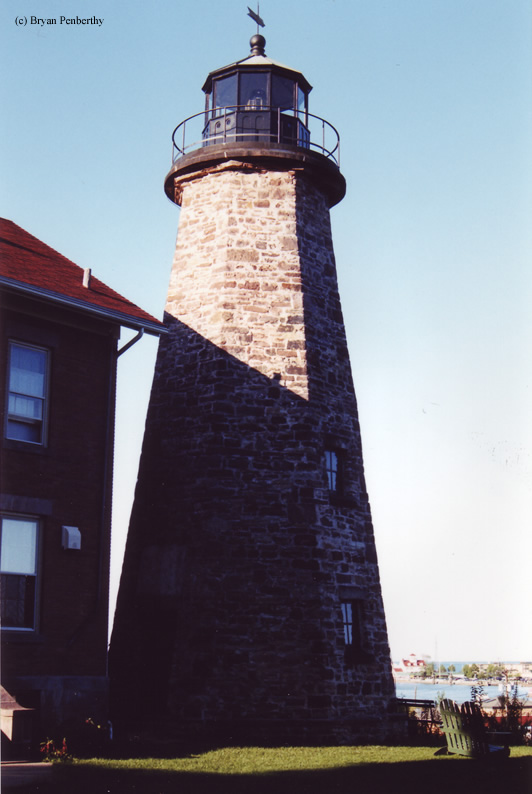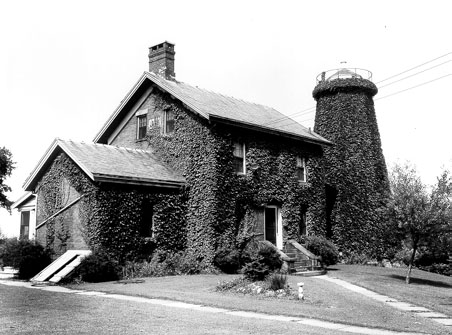Charlotte - Genesee Lighthouse
Rochester, New York - 1853 (1822**)

History of the Charlotte - Genesee Lighthouse
Posted/Updated by Bryan Penberthy on 2015-01-07.
Well before the Charlotte-Genesee Lighthouse was established in 1822, Oliver Phelps and Nathaniel Gorham of Massachusetts, already owning most of the land on the east side of the Genesee River, purchased a tract of 2.5-million-acres on the west side from the Seneca Indians in 1788.
Three years later, William Hincher, constructed a hut and settled the area with his wife, Mehitabel and seven daughters.
The Pulteney Association purchased the rights to much of Phelps' and Gorham's land in 1792. An agent acting on behalf of the group arranged the layout of the a new town, dividing the land into one-acre lots and called the area "Charlottesburgh" in honor of his daughter.
In 1796, Samuel Latta bought land at the mouth of the Genesee River for $175 and built a warehouse. By 1806, he was appointed Customs Collector of the Port of Genesee by President Thomas Jefferson in 1806.
By 1811, the small settlement at the mouth of the Genesee River was flourishing with the expanding commerce of the lake and river trade. The War of 1812 would stagnate the growth for several years, but at its end, trade once again rapidly increased.
To successfully enter the harbor, mariners, had to navigate around a sand bar, and rely on two crude lights, a lantern in a hotel window and one in a giant elm tree, nicknamed the "pilot tree." Once a vessel had made the pilot tree, they rang their bells until they reached shore.
To enable a safer and quieter way to enter the harbor, the federal government had recommended a lighthouse near the mouth of the Genesee River and appropriated $5,000 for it in 1820.
On November 17, 1821, the federal government purchased 3¼ from William Hincher's widow, Mehitabel for $400. Ashbel Symons completed the station in 1822, which included a tower, two-room keeper's dwelling, and a well at a total cost of $3,300.
 Lighthouse with birdcage-style lantern. (NA)
Lighthouse with birdcage-style lantern. (NA)
The octagonal sandstone tower had a base of 22 feet in diameter, with foundation walls 4½ feet thick and tower walls tapering from 3½ feet at the bottom to 2 feet thick near the top.
At the top stood an octagonal birdcage-style lantern standing eleven feet tall with 18 small "lights" or panes of glass in each section. Within the lantern was ten Winslow Lewis patented lamps and reflectors, fueled by whale oil.
By 1829, the sand bar at the mouth of the Genesee River was still problematic for mariners. To remedy this, the federal government appropriated $10,000 for harbor improvements and set about to erect a pair of piers.
The Army Corps. Of Engineers started construction of the piers in 1829. While construction was ongoing, Congress appropriated $4,000 in 1834 and another $3,750 the following year for beacon lights on the piers on Sodus Bay and the Genesee River.
Although money was appropriated for a lighthouse on the pier, it wouldn't be constructed for several years as construction of piers wasn't completed until 1836.
By 1838, many of the nation's lighthouses were being inspected and reported on by various members of the U.S. Navy. In the tenth lighthouse district, which spanned from the St. Lawrence River down into Ohio, Lieutenant Charles T. Platt handled the inspections. For the Charlotte-Genesee Lighthouse, he put the following text in his report:
Genesee light-house is lighted with 10 lamps and the same number of bright reflectors, fixed. The lamps are in bad condition, owing chiefly to wear. So far as the keeper is concerned, all is correct. The oil and other supplies furnished by the contractors are without fault.
The light-house wants repairing; the deck leaks; the lantern wants glazing, fourteen of the glass being more or less broken.
This light-house, it will be recollected, may be discontinued as soon as the one recommended in a former report is established at the end of the pier.
In another section of Lieutenant Platt's report, he had recommended to the government "the building of a permanent light-house, on a solid and durable foundation" at a cost of nearly $11,000.
Throughout that section of his report, he went on to detail the construction of a 45-foot tall lighthouse at the end of the pier, the materials to be used in its construction, and the specifications that it should be built to.
His recommendation for a new lighthouse on the pier, rather than a beacon light, was that it was more cost effective. If a new lighthouse was erected on the pier, the Charlotte-Genesee Lighthouse could be discontinued, generating a cost savings.
If a beacon light was built, the Charlotte-Genesee Lighthouse would still be needed, which would require its immediate repair and ultimately its replacement at some point in the future resulting in greater cost to the government.
It appears that Lieutenant Platt's advice was not taken as government documents describe the Genesee River beacon as "a beacon of stone, twenty-five feet high, an octagon of twenty feet in diameter, upon a foundation of forty feet square, in fifteen feet depth of water." This was the same design as the original Sodus Outer Lighthouse erected around the same time.
The 1822 tower was kept in service as a beacon light on the west pier was established as a secondary light.
By the 1850s, as the Lighthouse Board assumed oversight of all navigational aids in the United States, they adopted the use of the more efficient Fresnel lens. The Charlotte-Genesee Lighthouse received a 180° fourth-order Fresnel lens power by two concentric burners in 1855.
In 1863, a spacious new two-story keeper's dwelling was built adjacent to the 1822 tower. Over the years, minor repairs were made, but nothing was worth mentioning in the Annual Report of the Lighthouse Board until 1880, when the woodwork of the dwelling was repainted.
A year later, a new wooden sidewalk was laid in front of the lighthouse grounds and a few other minor repairs were made to the dwelling.
A new iron tower was erected on the west pier in 1881, and at that time, the fourth-order Fresnel lens from the Charlotte-Genesee Lighthouse was transferred to the new tower. On February 28, 1881, the old 1822 tower was discontinued.
 Charlotte-Genesee Lighthouse w/o lantern (C.G.)
Charlotte-Genesee Lighthouse w/o lantern (C.G.)
The iron tower would only serve for a few years before being discontinued on March 18, 1884. Duties were taken over by a new wooden tower that would be erected on the west pier. The lantern for the new wooden tower was taken from the discontinued Charlotte-Genesee Lighthouse, leaving the tower covered by an unsightly cap.
In 1886, some exterior work was carried out on the dwelling. The work included taking up 198 feet of plank walk, grading the area, and then relaying the walk with new material. Also, the sills, floor, and approach to the barn were replaced.
On January 31, 1892, the Rochester Electric Railway Company began leasing a strip of land on the grounds of the Charlotte-Genesee Lighthouse and a portion of the waterfront. The terms of the lease deal were $25 per year for the strip of land and $1 per year for the waterfront.
The lease to the Rochester Electric Railway Company had expired on January 30, 1896 and the company had not removed their property from the premises. As such, the federal government brought forth a lawsuit forcing them to vacate. By the following year, they had complied with the order.
By 1897, the federal government had to bring forth another lawsuit regarding the Charlotte-Genesee Lighthouse property. The case had to do with a 50-year lease executed on October 28, 1864 with an individual named William Rankin. His lease was being terminated for "nonfulfillment of the terms of the lease."
The problems didn't end there. That same year, a branch of the New York Central Railroad was laid across the lighthouse property, of which no permission was granted. It is unclear what was done about this as there is no further mention of it.
Both pier lights were automated in 1947, relieving the keeper, Wilbur L. Folwell, Sr. from his post. He was transferred to the lighthouse at Oswego, and then went on to serve at other stations, before returning to Oswego, where he would eventually retire.
When Keeper Folwell left for Oswego, the local chief of the Coast Guard moved into the dwelling, where he lived until 1982.
In 1981, the Coast Guard asked the Charlotte Community Association if they had an interest in leasing the property while they decided what to do with it. The association agreed, and in September 1982, leased the buildings.
At that time, the Charlotte-Genesee Lighthouse Historical Society was formed to care for and restore the historic structures. Students from Edison Technical High School constructed a new lantern, which was installed in 1984.
The Coast Guard then loaned the group a fourth-order lens, allowing the tower to be relit on June 18, 1984, one hundred years after it had been discontinued. Over the years, the historical society has maintained and polished the lens as needed.
The property was declared excess in 1991 and deeded over to Monroe County. The Charlotte-Genesee Lighthouse Historical Society has a 20 year lease on the property and operates the premises as a museum.
It was learned in 2007 that the fourth-order Fresnel lens installed at the Charlotte-Genesee Lighthouse was originally from a lighthouse in Lorain, Ohio. As that lighthouse was undergoing restoration, they requested their lens be returned, resulting in a feud over the lens.
A historian with the Coast Guard said that the lens was on loan to the Charlotte-Genesee Lighthouse until 2011, at which time, it would revert back to the Coast Guard. That took place in 2011, leaving the lantern of the Charlotte-Genesee Lighthouse empty.
On February 24, 2014, the fourth-order Fresnel lens was returned to the Port of Lorain, to be put on display.
By 2014, the brick collar on which the steel lantern of the Charlotte-Genesee Lighthouse rested was deteriorating. That same year, an anonymous local family donated a reproduction of a fourth-order Fresnel lens created by Artworks Florida to the Charlotte-Genesee Lighthouse Historical Society.
These two things were the impetus the needed to start a thorough reconditioning of the lighthouse.
Phase 1 of the project included removal of the lantern, restoration of the brick supports on the tower, new wood walls for the lantern, and paint. The cost for phase 1 was approximately $189,000.
Phase 2 will kick off in spring of 2015 which will include more painting, brickwork, some welding, and the door to the tower will be fixed.
Reference:
- Annual Report of the Light House Board, U.S. Lighthouse Service, Various years.
- Various Government Documents, Federal & State Governments, Various dates.
- "Charlotte-Genesee Lighthouse installation postponed," Sarah Taddeo, Democrat & Chronicle, September 19, 2014.
- "Historic lens to return to Lorain," Richard Payerchin, The Morning Journal, August 10, 2011.
- "2 Old Lighthouses Compete for a Historic Lens," Michelle York, The New York Times, December 26, 2007.
- Great Lakes Lighthouses Encyclopedia, Larry & Patricia Wright, 2011.
- "The Charlotte-Genesee Lighthouse and the Lights of Rochester Harbor," Timothy Harrison, Lighthouse Digest, January/February 2011.
Directions: Follow Route 104 into Rochester. You will be looking to turn onto Lake Ave...it will be the same corner the big Kodak building is on. As you head north on Lake Ave., look for Holy Cross Church, it will be on your right. Make a right into the parking lot, and the Charlotte-Genesee Light is in the back of the parking lot.
Access: The lighthouse is owned by Monroe County. Grounds open. Tower open in season.
View more Charlotte - Genesee Lighthouse picturesTower Height: 40.00'
Focal Plane: 45'
Active Aid to Navigation: Deactivated (1881)
*Latitude: 43.25300 N
*Longitude: -77.61100 W
See this lighthouse on Google Maps.
